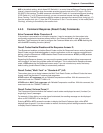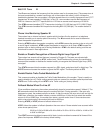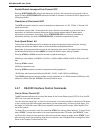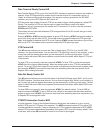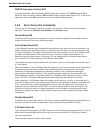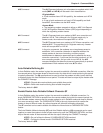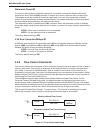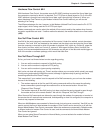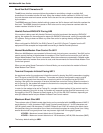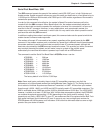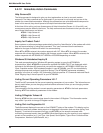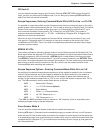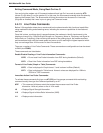
41
Chapter 4 - Command Mode
Hardware Flow Control &E4
With Hardware Flow Control, the modem uses its RS-232C interface to control the flow of data from
the computer or terminal to which it is attached. The CTS (Clear to Send) signal on Pin 5 of the RS-
232C interface is brought low to stop the flow of data, and is brought high to restart it. When you
select Hardware Flow Control as your Modem Initiated Flow Control method, you will also be
selecting it for Pacing.
The difference between the two, however, is that Modem-Initiated Flow Control uses the Pin 5 CTS
output signal, while Pacing uses the Pin 4 RTS input signal.
Modem commands are used to select the method of flow control used by the modem when its error
correction capabilities are used. If neither method is selected, the modem defaults to no flow control
(
&E3
).
Xon/Xoff Flow Control &E5
Xon/Xoff is the most commonly used method of flow control. Under this method, control characters
known as
“Xon”
and
“Xoff”
are inserted by the modem into the data to start and stop the flow of data
from the computer or terminal to which the modem is attached. Xoff, which is a Control-S, stops the
flow of data, and Xon, which is a Control-Q, restarts it. With regard to Binary Data, Xon/Xoff flow
control is not recommended because an Xoff character may be part of the data and would trigger an
Xoff of the modem or software package, which would halt data flow.
Xon/Xoff Pass-Through &E7
So far, you have had three choices to make regarding pacing:
1. You can set the modem to respond to Xon/Xoff pacing.
2. You can set the modem to respond to RTS pacing.
3. You can set the modem to ignore pacing completely.
Well, we’re not done with pacing yet. There’s another choice you can make (which actually can apply
to both pacing and modem-initiated flow control, although it applies mainly to pacing) and that is
something called Xon/Xoff Pass-Through.
This means that if your modem is set to respond to Xon/Xoff commands, you can have the modem
do one of the following:
1. The modem responds to the Xon and Xoff pacing commands while at the same time allowing
these commands to pass through the modem and on to the remote location. We call this
“Respond, Pass-Through”
.
2. The modem responds to Xon/Xoff pacing, but does not allow the pacing signals to pass through
the modem and on to the remote location. We call this
“Respond, No Pass-Through”
.
When Xon and Xoff commands are allowed to pass through the modem, the computer or terminal at
the remote site will receive these commands, and depending on how it is configured, the computer or
terminal may respond to them also.
When two MultiModems are connected in Normal mode (not using error correction), Xon/Xoff can be
used to control the flow of data between the modems. Flow Control can be turned on or off with the
Normal Mode Modem Flow Control commands. When the modems are connected in Reliable mode,
a different method of modem Flow Control is used, and the commands for Normal Mode Modem
Flow Control are ignored.
When you are using Speed Conversion in Normal Mode, you must activate the modem’s Normal
Mode Modem Flow Control.



